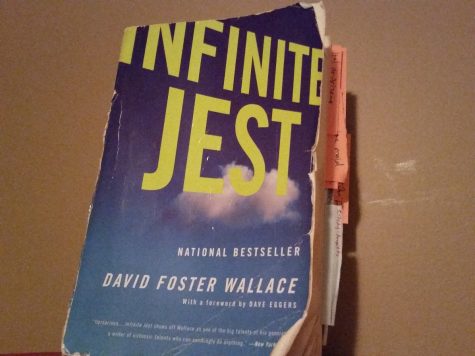No Joke, Addictive ‘Infinite Jest’ Mesmerizes
May 17, 2016
“A brain that can come up with (“Infinite Jest”) is not a normal brain.”
Trinity English teacher Mr. Matt Manning speaks of author David Foster Wallace, who suffered from depression and committed suicide in 2008 at the age of 46.
This year Wallace’s “Infinite Jest” turns 20 years old. At 981 pages (and an additional 96 pages of footnotes), its reputation is almost as big as the book itself. The notoriety is mostly due to the length, as well as the endless endnotes.
The hardest part about the book is finding the motivation to start it — and cultivating the discipline required to keep reading. I bought the book for $1 at a used book store, so I had no qualms about letting it lie on my shelf for eternity, destined to become nothing more than a conversation piece. I am glad that I read it before it became a “maybe someday” kind of a book, because it is without a doubt the best book released in the past 20 years.
Manning estimates that he read the book around 2002. “There are scenes that, even 15 years later, I still remember,” Manning said.
“Infinite Jest” was his introduction to Wallace. Since then he’s read the short story collection “Brief Interviews with Hideous Men.” He is currently reading Wallace’s “The Broom of the System,” which was released in 1987.
Manning said, “When I read (“Infinite Jest”), it was relatively new to people. It had gotten an interesting review in the ‘New York Times Review of Books.’ It looked interesting, very postmodern in its setup, with pages and pages of footnotes.”
Manning was taking a class on postmodern literature when he started the book. The class had sparked his interest in books like Don DeLillo’s “White Noise” and Thomas Pynchon’s “The Crying of Lot 49.”
Manning recalled reading it as feeling like both a chore and a challenge, saying he “can see why a lot of people don’t make it through that book. (‘Infinite Jest’ and ‘The Broom of the System’) really are kinds of books that you can put down for an extended period of time and pick back up. You’re not going to be any less lost than you are. Take it slow. Make sure you read the endnotes.”
Manning finished the book, but never reread it. He said, “I have it on my shelf, and I’ve often thought about taking it up and reading it again to see how much I’ve changed over 15 years and how it would affect me differently. But I’ve never picked it up again.”
The book is set in the near future — well, the near past for 2016 readers. The events in the book take place from 2002 to 2009. That being said, don’t come in expecting a dated sci-fi novel. The “future” is an absurd prediction of where Wallace thought contemporary society was headed, and his predictions are pretty spot-on.
There are three big storylines occurring throughout the book. I won’t try to dive too far into the plot for this review, because you should try to avoid as many spoilers as possible if you plan on reading the book. The less you know, the better.
I’ll stick to the basics: The United States, Canada and Mexico have unified into a single state known as the Organization of North American Nations. An area of northeast America/southeast Canada is used as the nation’s landfill, and many Quebecois are upset about having to live around a toxic waste dump.
Also, years are no longer denoted numerically; they are advertisements. Companies pay to have a year named after their product: Year of the Whopper, Year of the Depend Adult Undergarment, etc.
The second storyline is centered on Enfield Tennis Academy, notably founder James Orin Incandenza, who was also an experimental filmmaker. He has three sons: Arizona Cardinals’ punter Orin, current ETA student and tennis prodigy Hal (can be considered the “main character” of the novel, if there is one), and the optimistic, disfigured Mario.
The third storyline revolves around the Ennet House, a rehab facility. Don Gately, former criminal/drug addict and current counselor at Ennet House, is the main character of this particular storyline. The residents have essentially been rendered powerless by their addiction, and it is a good juxtaposition to the best-of-the-best at ETA, where corporations will pay big money to have their logo on one of the top player’s gear.
The entire plot essentially ties back to one object: “The Entertainment,” a movie that is so addictive that the viewer would rather die than stop watching it. Videotapes of “The Entertainment” have been spreading around the country, and one of the big questions of the novel is who did it and why –which becomes apparent on a second read through. The bigger question concerns why it was made in the first place.
Manning said, “(Neil) Postman wrote a book, and it was nonfiction. It’s called ‘Amusing Ourselves to Death’ and it’s about how the culture that we live in, how much sitting we do, watching stuff, videos. It always makes me think of the videotape.”
The plot, however, is secondary to the messages the author wanted to communicate, messages touching on themes of addiction, recovery, entertainment, success, depression, family, patience, trust, sincerity vs. irony, perception vs. reality, and what those themes mean to contemporary Americans.
Addiction is the most prevalent theme of the novel, since many of the characters are addicted to something, be it fame, entertainment, “The Entertainment,” alcohol/drugs, or addiction itself.
“Infinite Jest” is an addictive book. Once I’d gotten far enough in, it sort of dominated my thoughts. There is so much going on, trying to wrap your head around it can be time consuming. I tried to squeeze a few pages in every chance I could, and I really couldn’t get enough of it. I felt guilty if I spent my free time doing anything but reading it.
Reading the book emulates the themes and experiences of the characters. You feel like you are playing a game of tennis when you flip back and forth from the main text to the endnotes. The maximalist style tends to a pursuit-of-success theme in the sense that the book is like an endurance test.
Reading through the novel is also like going through Alcoholics Anonymous. A common saying in AA that is used throughout the book is “Keep Coming.” You may not be sure how exactly you will benefit from reading the book, and the only thing you can really do is either quit the program or Keep Reading. You feel as if you are becoming an AA veteran as you continue to plow through. For example, many plot points that confuse newcomers will make perfect sense to you.
Once you finish the book, you’ll most likely feel the urge to Keep Coming Back. There’s a reason why people who have been sober for decades still go to AA meetings.
The novel also emulates “The Entertainment.” You may be confused at first, but there is definitely a hypnotic element.The book will be on your mind as you read it — and will stick with you long after you finish it.
Manning said, “After a time it just became a chore but also a challenge: ‘I’ve gotten too far into this and too concerned about these characters, and I just need to find out how it ends up.’ I took a creative writing course soon after (reading the book). I wrote a story in which there were tons of footnotes. I was trying to copy that frame….How does one create a story like that?”
When I was reading the book, I cut out television, streaming services, movies and other books, and also severely limited the time I spent on the Internet and social media. It is all-consuming. Even when you finish it, you are drawn back.
“Infinite Jest” also serves as the anti-“Entertainment,” in a way. Viewers of “The Entertainment” sacrifice their willpower to a higher being. Reading this book takes a lot of willpower, as well as discipline. “The Entertainment” lets viewers tune out and be mesmerized. “Infinite Jest” demands that readers actively engage with the book.
Wallace is obviously against the immediate gratification that we, as Americans, demand in so much of our entertainment. There is no immediate gratification in the book. It requires close attention and a good amount of time in order to stay on track.
“Infinite Jest” is also a commentary on how addicted we are to stimulation. Like AA, the book is weaning you off of tasty-but-worthless entertainment, things like never-ending Twitter feeds and Netflix binges. The author knows that reading a 1,000-page book is off-putting, and that is sort of the point:
How hard is it for us to commit to a single thing when we are bombarded with so many choices? It’s not just Wallace wagging his finger at you, though. The story becomes very interesting and engaging once you know the characters and the world, so you feel compelled to keep reading.
“I’ve abandoned books before, but not this one — but only because its construction was ‘I’ve got to see where this is going,’” Manning said.
The overstimulation Wallace criticizes is felt by reading the book. We are bombarded with information everywhere we look, and the maximalist style reflects that. I’ve compared the experience of reading the book to a lot of things, and television is another good comparison. Though this book will never be fully adaptable into any medium other than literature, it mimics the ways in which we experience channel surfing.
We flip back and forth between a few programs (What’s going on at ETA? What about the Ennet House?) and are taken out of the experience by advertisements (endnotes). The endnotes-as-advertisements idea is strengthened by this quote from the book: “It did what all ads are supposed to do: create an anxiety relievable by purchase.”
If you skip the endnotes, you will most likely feel as if you are missing something. Sometimes you will miss out on something important; other times you’ll flip to the back of the book and be met with something that holds no value to you whatsoever.
The book was very ahead of its time. Wallace’s predictions about entertainment and communication are very on-the-nose.
Manning said, “He’s always setting his books in the future, but the near future. It’s almost like he could see where this was going, you know a society that gorges on media to the point where it’s bad for us.”
One chapter essentially predicts Facetime, and even provides and explanation for why it didn’t replace phone calls. The device is called a “videophone,” and it failed because of the emotional stress of appearing on video, as well as physical vanity. When talking on a phone, you can feign interest — this has since extended to texting, where you don’t even need to modify your voice to fake an emotion. A videophone call forces viewers to appear interested for the entirety of the call.
The “physical vanity” element comes into play when considering how a person on the other end of an audio phone call can’t tell anything about your appearance. Viewers looking into videophones are horrified at the look of their face on a screen (How many times have you seen a picture of yourself that inspires you to break all of the mirrors in your home?). The solution to the videophone users’ problems is sold to them in image-enhancements.
At first it is just small touch-ups; then it goes to wearing masks of the user’s own face and eventually reaches the point where users put an image of a celebrity onscreen. Of course, people catch on and realize they are essentially paying money to alleviate an anxiety that never existed before the product entered their life — and the videophone fails.
Communication is also covered in great length. Many characters in the book have trouble communicating due to cultural, personal or lingual barriers. Flipping between the main text and endnotes also serves as a commentary on how fragmented communication is in the modern age. It is sort of like juggling a phone call and texting at the same time.
Stylistically, the book can be placed in the category of postmodern. “Clearly, he’s influenced by Thomas Pynchon and that whole group,” Manning said.
The book’s first 200 or so pages are all over the place. Dozens of characters are introduced, and it is hard to tell which ones to pay attention to. Many terms, events, names, nicknames, and acronyms crucial to the novel are tossed around as if you are expected to know them already.
That being said, the majority of the things that confuse you on first reading will be crystal clear on your second read — your first instinct after finishing the book will be to read it again. The first read lays out the dots for you, and subsequent reads are where you will connect them. 
The endnotes (388 in total) may seem like a gimmick at first, but they are absolutely essential to the experience.
Manning said, “I remember on my initial reading wondering ‘How important are these?’ and then realized pretty quickly that there is some important stuff in there. Some of them are chapter-long.”
After a while, I wasn’t bothered when I saw an endnote. I got used to them after flipping to the back of the book about a hundred times (it is useful to have a bookmark exclusively for the endnotes). A lot of them are brief factoids that don’t contribute anything to the plot, and a few of them are several-page-long chapters that contain crucial information.
Some of them are just funny observations about a character or event in the novel. The endnotes are a gamble, in that sense. If you skip an endnote, there is a possibility that you may miss something important.
The style also varies with the point of view. The majority of the book is told in third-person view, but there are a few chapters in first-person. There are a couple of stream-of-conscious chapters, but they are few and far between.
At ETA, bigger words are tossed around, the writing is a bit more academic, and even condescending at points.
At Ennet House, the writing is a bit more straightforward, occasionally stream-of-conscious, and more prone to vulgarities.
One of the biggest strengths about Wallace’s writing is how well he is able to depict minutia. The description of a gesture or a verbal tic makes it easy for a reader to visualize scenes, and adds color to otherwise boring passages.
Unfortunately, one of the biggest weaknesses also lies in his writing. You get the sense that Wallace is showing off in some of the denser and complicated sections, and it can be sort of exhausting. I understand that going off on tangents is part of the maximalist style, but some of it just seems like self-indulgent overkill.
Wallace isn’t trying to punish you with this book. In fact, the book is incredibly rewarding if you are able to stick with it. It is not a perfect novel, but the good outweighs the bad. There were definitely times where I felt bored/frustrated, but the thought of giving up on the book never crossed my mind.
This is a book that can be difficult to recommend someone, because there is always the possibility they will read the first 100 pages and dismiss it. I also find it hard to push a 1,000-plus-page book on someone, because it really is a serious commitment. To tell them they ought to read it more than once is madness.
However, if you are interested in a challenging and unique reading experience, definitely give it a go. The ideas held within the book are still culturally relevant in 2016, maybe even more so than they were in 1996. It is a complex novel, but Wallace sort of holds your hand throughout. If you can move past the obscure vocabulary and various pharmaceutical terms, it is really not that difficult.
So what did Wallace hope to accomplish with this novel? It’s hard to concretely say. He tackles a wide range of topics and juggles multiple storylines. He is able to make a coherent narrative out of a deceptively messy novel. He offers a critique of society that forgoes the tried-and-true irony-drenched “point-and-laugh” satire. The book is not perfect, but Wallace’s success in enough areas makes the failings forgivable.
Manning was able to sum up the novel in a sentence: “I learned a lot about AA — and tennis.”


